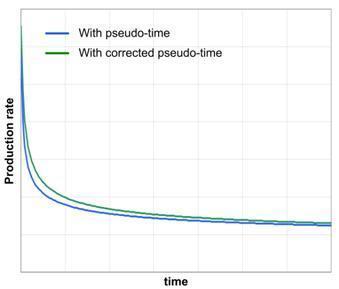Corrected Pseudo-Time
| Note: | This definition of corrected pseudo-time has only been implemented in the advanced, analytical horizontal multi-stage fracture models. |
In the conventional definition of pseudo-time, the compressibility and viscosity terms are evaluated at average reservoir pressure conditions. Clearly, the average reservoir pressure is only a function of original-gas-in-place (OGIP) and cumulative production. During the transient flow period, before any boundary effects are observed, the flow behaviour of two different-sized reservoirs should be similar, and independent of the OGIP – they are both infinite-acting reservoirs. However using the conventional definition of pseudo-time, the result would be that the producing rates would be different because their average reservoir pressures are different due to the different OGIPs.
If a well is producing under boundary-dominated conditions, the average reservoir pressure is a very reasonable datum at which to establish fluid properties such as cg. However, if the well production is still in transient flow and no reservoir boundaries have been observed, the average reservoir pressure based on total reservoir volume is not an appropriate datum to use. Consequently, pseudo-time can cause anomalous model responses under certain conditions.
Anderson and Mattar (2007) proposed that the average reservoir pressure used in the pseudo-time calculation during the transient flow period should be calculated based on the gas-in-place of the investigated volume at that time (as determined by the radius of investigation). This way, during transient flow, pseudo-time is independent of OGIP. As soon as the reservoir enters boundary-dominated flow, the conventional definition of pseudo-time is automatically resumed, because at that time the region of investigation is the whole reservoir.
The volume of investigation is calculated based on the radius of investigation formula:
This volume is adjusted for the effect of the reservoir boundaries, and the coalescence of regions of influence caused by interference between wells.
